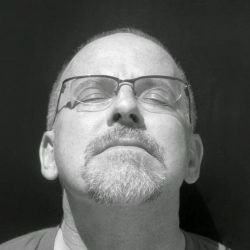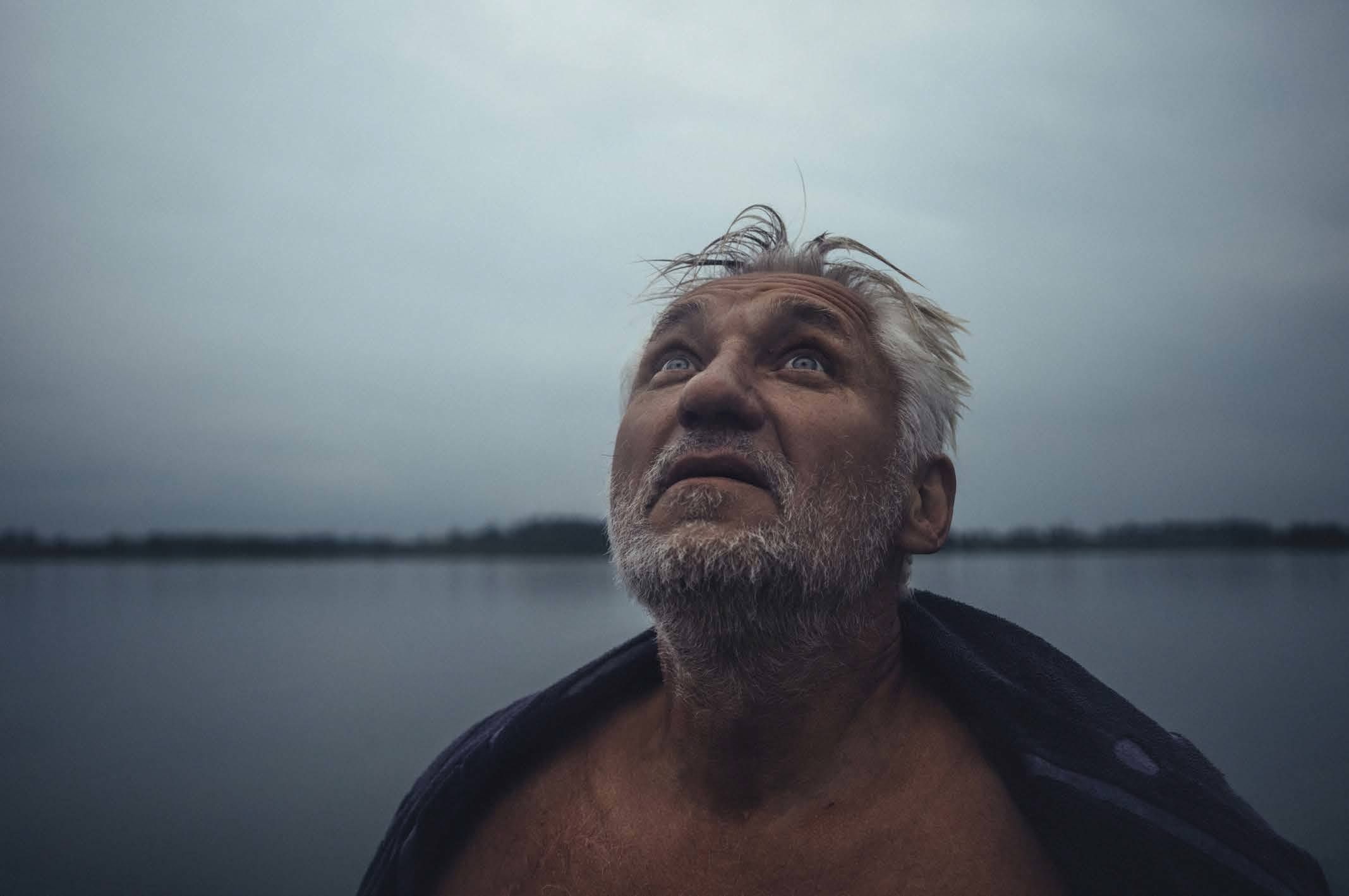Introduction
"I’ve never met a photographer who didn’t have big dreams. It comes with the territory of having a creative soul."
Through my research of Mitchell, I’ve learned a few things about him.
I’ve learned that he is a family man, with a kind spirit.
He’s also an awesome photographer.
That’s an understatement really; he’s a fantastic photographer that displays incredible talent in a number of ways (ways that we will discuss with him shortly).
Many of us probably already realize this, but in case you’re not familiar with Mitchell, here are just a few of his many accomplishments:
- In 2015, he was named Travel Photographer of the Year in the category “People/Faces.”
- He is a Panasonic Lumix Ambassador and was chosen as a featured photographer for the worldwide advertising campaign that launched the Lumix G80/81 camera.
- He is represented by Getty Images.
- He has been published in National Geographic Traveler, Lonely Planet Traveler, Vanity Fair, and Geographical UK (to name just a few).
- He has created his ideal career, where he calls his own shots and doesn’t need to depend on assignments or to be in specific locations.
All of that is pretty impressive, but what really makes him stand out (in my mind) is that he is a genuinely super nice guy!
If you investigate him at all, you will come to realize how open he is to revealing everything that he is currently doing in photography, much about his past, and some really insightful declarations about his personal views on photography, photographic editing, and life in general.
For example, Mitchell did not begin his adult life as a professional photographer.
He was a hobby photographer in Australia; that was up until 2005. It was in that year that he made a huge decision (he dreamed big) that he wanted to live his life as a professional travel and documentary photographer.
That decision was followed by a three-month (selffunded) photo safari across the vast lands of India.
Mitchell Kanashkevich’s big dream was off and running.

If you look up “travel photography” on Wikipedia, Mitchell is listed second, right under the infamous Steve McCurry of National Geographic Magazine fame. Kanashkevich is highlighted as an “example” website to view exquisite travel photography. Not bad for a hobbyist photographer that began his “big dream” only a decade or so ago! Screen capture by Kent DuFault
When I learned that I was going to get the opportunity to interview Mitchell, I’ll admit it: I squealed with joy! I love talking with photographers who are at the pinnacle of their profession. I love finding out what makes them tick.
I have a two-fold mission with this interview:
- I want you to learn something about Mitchell – the man, the person that you won’t read anywhere else.
- I want to further inspire your big dream through Mitchell’s revelations to us about his journey, so that you can visualize the possibilities for yourself and make a plan!
Before we dive into the interview, let’s warm up with a few amazing images by Mitchell Kanashkevich!
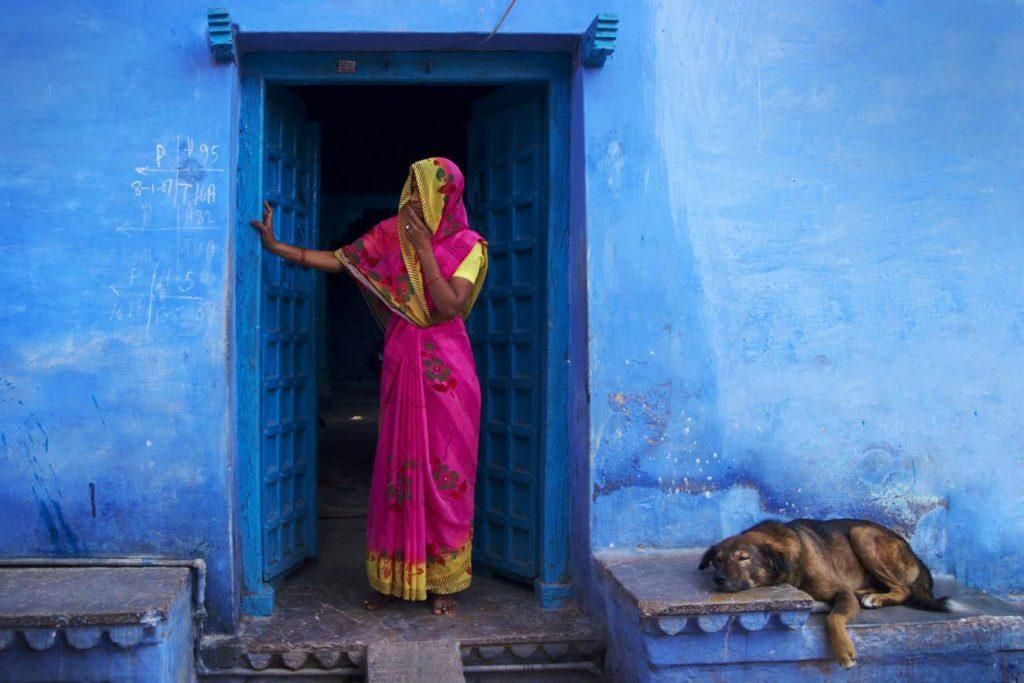
A street scene in a small town in the region of Bundi, India. There are certain towns and villages in India that are absolutely surreal in terms of the colors and incredible subjects. For a foreigner like me, it’s like an exotic film set. Photograph by Mitchell Kanashkevich
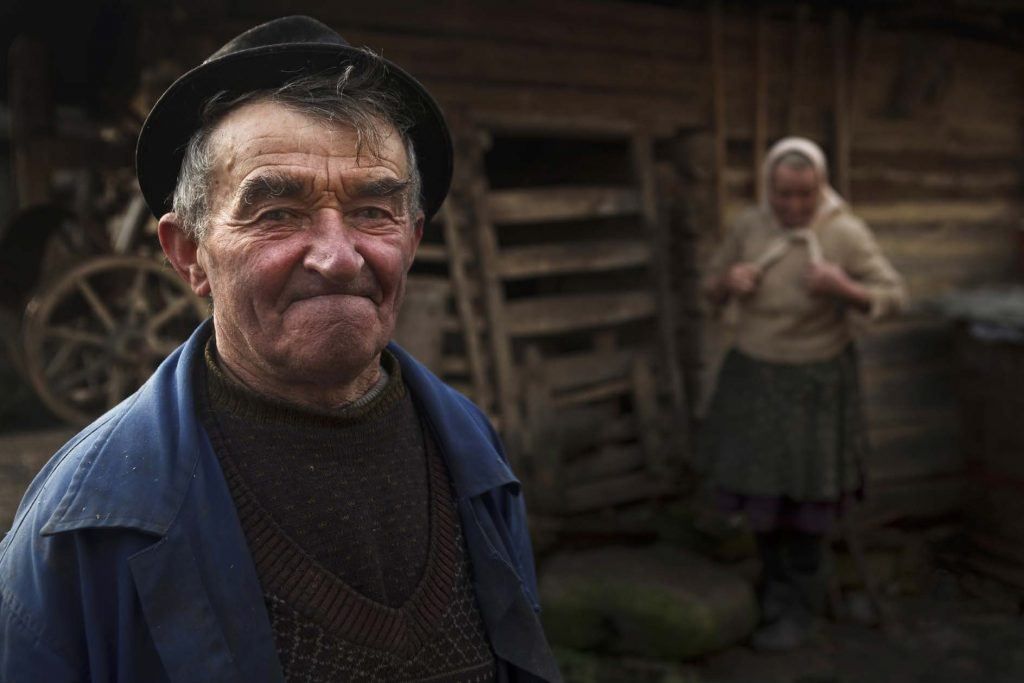
A rural man and his wife in Maramures, Romania. They are standing in front of their pig sty. The people in rural Romania depend a lot upon their land and their animals. They’re very open, and they’ll gladly show any curious wanderer around their homes. Mitchell: “I shot this while traveling with two Romanian friends. The couple in the photo actually showed us inside, but it was much too dark to photograph. When we came back outside, I saw this opportunity to make a portrait of them in a very natural setting.” Photograph by Mitchell Kanashkevich
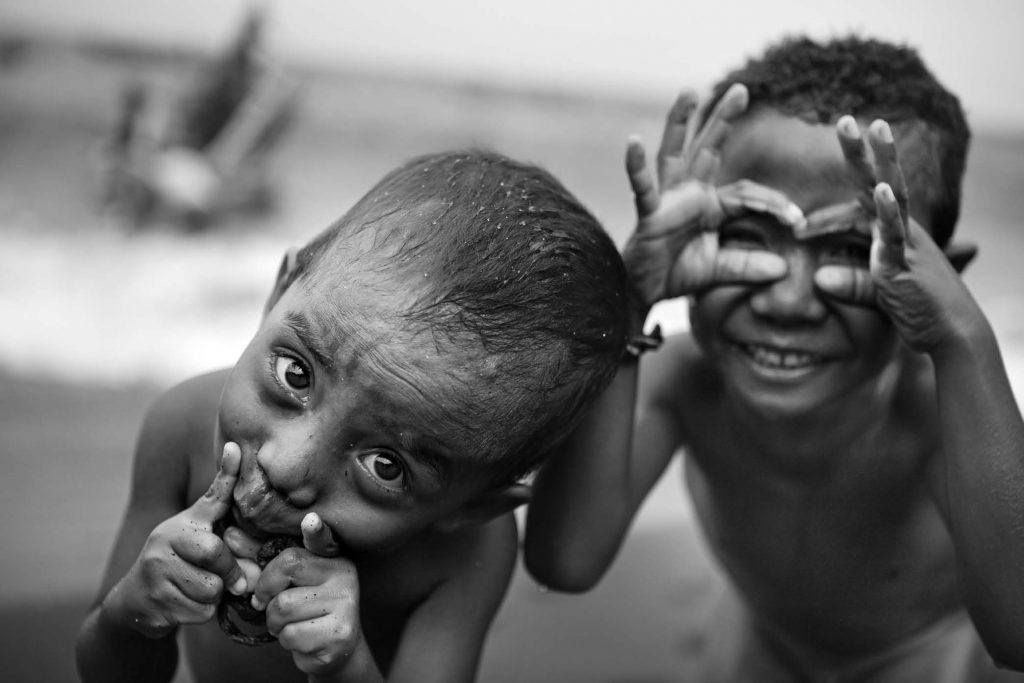
Children playing on the beach of the whaling village Lamalera, Indonesia. Photograph by Mitchell Kanashkevich
The Interview
Kent: “Mitchell, thank you for taking the time to meet with me and agreeing to share your photography, and perhaps some moments from your life with all of us here at Photzy.”
Mitchell: “Not a problem, Kent. My pleasure.”
Kent: “In stalking you online – just kidding! – I noticed that you frequently talk about your wife and your child. Was your wife there with you at the beginning? Was she onboard when you decided to pursue travel photography as your dream? Or, did you have to convince her?”
Mitchell: “My wife, then-girlfriend, was with me from the beginning. I guess she liked traveling too, and before we both knew it the whole thing turned into a lifestyle. She did help me out a lot in the beginning when I used to use artificial lights, reflectors, etc.
Now more of her attention goes to our little girl, but having them both around definitely makes things easier. When they’re with me, I don’t get homesick at all. To me, home is where your close ones are. The place doesn’t matter.”
Kent: “I had a very defining moment in my life when photography ‘took over.’ I was 14 years old and taking a basic photography class in my school. The teacher had taken a portrait of a fellow classmate, and we were all gathered together in the darkroom watching the image appear in the developer. When I saw the print, when I saw how ‘good’ my classmate looked in the photo, it blew me away. It was in that defining moment that I realized the possibilities that photography held for me. What was your defining moment? Can you tell us when that instant was in your life? What was the picture, or what was the situation?”
Mitchell: “It was more of a gradual realization. I studied film history and theory, but I wanted to make films. I did make two documentary films. While I still think the ideas were great, they were very student-ish. I was fresh out of university and, like many youth, I thought I knew everything. I wanted to come up with my own style before really going through some of the basics in terms of how I’d deliver my story.
I was a bit disillusioned with film after my two projects didn’t make me a single cent. I did win an award for best editing at a small festival in France, but that was it. This was before YouTube or Vimeo. I felt like, if I didn’t make money, and if very few people saw my films, there was no point in making them and spending all the time and money. Again, this is like 15 years back. Things are easier than ever now in terms of gear, costs, and finding an audience.
I had been shooting photos during my film projects too, and I was always interested in the visuals above all else. At one stage, I said to myself, ‘I’ll go to India, and I’m going to become a travel photographer.’ As simple and naive as that.
I went to India and shot loads of photos. It turned out that making exactly the kinds of photos I wanted to make was also commercially viable. I didn’t need to compromise my ideals. Photography was also much simpler in terms of gear and the time spent at the computer.”
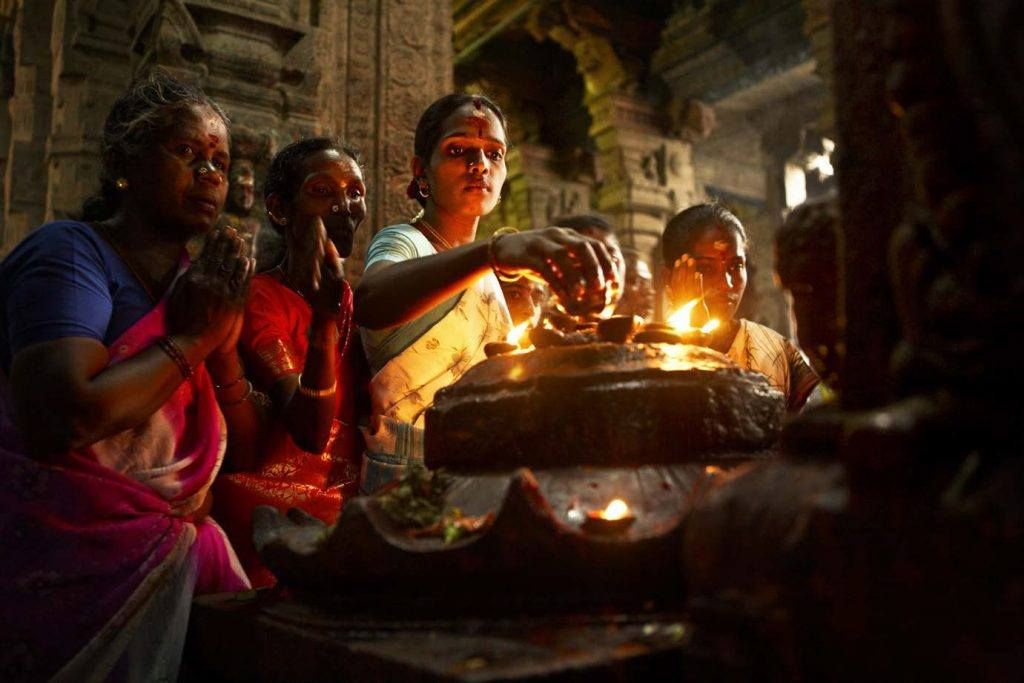
Hindu women praying and getting blessed by the holy fire at a temple in Madurai, India. Photograph by Mitchell Kanashkevich
Kent: “You began your dream by taking a three-month photo excursion across India. I have several questions about this. Were you scared? Do you speak any of the 23 language dialects of India? Did you have a plan? Or was it simply, ‘Let’s go do this thing!’”
Mitchell: “The first trip was actually five weeks. My first time in India was meant to be a three-month trip with my future wife, but some things fell through at home, I couldn’t wait, and went alone. I wasn’t scared, but I was very anxious. I read so, so much about India. It became a mythical country in my mind. I thought about it and dreamt about it.
I didn’t speak any of the languages. I didn’t know anyone. I had a very, very rough plan. I simply said to myself: ‘I’ll go to this region and see what I find there.’ I love journeys like this. To me, this is what travel and adventure is about.
India ended up teaching me countless lessons. Even if I didn’t fall in love with it at first, I absolutely fell in love with it by the end of the trip. It’s the one country which I owe most to as far as my photographic career goes.”
Kent: “I watched some videos that showed you at work. I was very impressed with how you walk into a situation – primarily in a foreign country – and somehow your subjects relate to you and open up to you in an almost mystical way. How do you do this? Do you have some tips for those of us that don’t possess those personality qualities?”
Mitchell: “Working with people is not the easiest thing in the world. If you’re an extrovert, it definitely helps. I’m somewhere in between, so I feel that I did have to teach myself to feel comfortable with approaching people.
Again, India taught me a lot here. Before India, I would never approach people. I was too shy. I felt like I was invading people’s privacy and couldn’t fathom that some people might actually want to have their photo taken. During my first couple of days in Delhi, I had so many locals actually request me to photograph them that I was overwhelmed. But I did learn that people don’t inherently hate being photographed. That was a big thing for me psychologically. I built up my confidence in India and then I used the same approach everywhere else I traveled to.
When it comes to photographing people, I think the main tip is to try to position yourself for success.
Photograph people in situations where they’re happy to be photographed – festivals, shows, celebrations, etc. Then, once you believe more in yourself, you can handle the occasional rejections much better. It’s then easier to understand that the entire world won’t say no to a photo and some might actually enjoy it.”
"Working with people is not the easiest thing in the world.. so I feel that I did have to teach myself to feel comfortable with approaching people"
Kent: “How many different countries have you visited? Do you have one that is your favorite place to photograph, and why?”
Mitchell: “I’m not really into counting the countries, since my aim is never really the quantity. I want to experience all the places that I visit in a meaningful way. That means that I generally stay longer, and so I don’t necessarily have the time to move from country to country quickly.
There are a few countries that I really fell in love with, or that were amazing photographically. Romania, Armenia, Mauritania, and Indonesia are just some that come to mind.
However, if you’re talking about a single favorite, it is India hands down. India provided the most incredible assault on the senses with some of the most amazing people that I’ve met in my life.
I think there’s a sentimental reason too. My work from India is what really put me on the map as a photographer.”
Recommended Reading: Want to improve your storytelling skills? Grab a copy of this bestselling premium guide, Powerful Imagery, by award-winning photographer, Mitchell Kanashkevich.
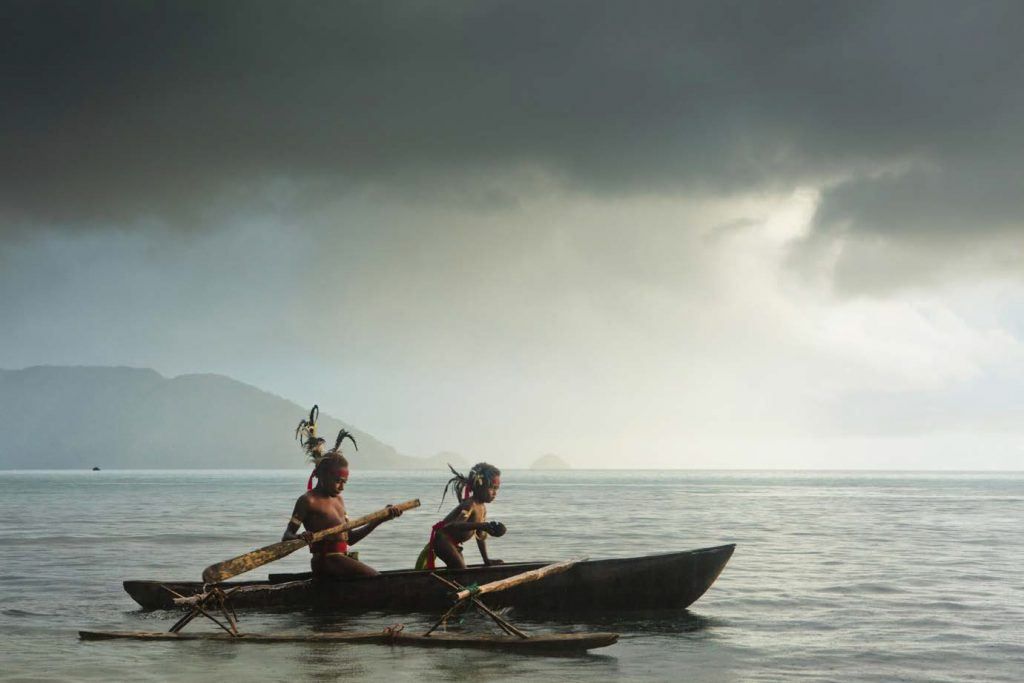
Children in a traditional boat in South West Bay, Vanuatu. This was for a tourism campaign that I shot for the local tourism industry. Photograph by Mitchell Kanashkevich
Kent: “Photography has become a twopart process. You have the act of clicking the shutter and creating an image incamera, and then you have the postprocessing side. In my view, the postprocessing side has really become of equal importance to the in-camera side. What are your feelings on this? How much importance do you place on each step? Do you shoot your photographs keeping the post-processing in mind?”
Mitchell: “I think that the actual phototaking is more important than postprocessing, since without a great photo there’s nothing to post-process. Also, I don’t believe that you can save a crappy photo with post-processing.
However, I have learned a long time ago that without at least certain steps in postprocessing your most amazing images will not seem that amazing to the audiences. You’re not making the most of your hard work if you don’t know why and how to postprocess your photographs.
So I definitely place a lot of importance on both processes. And yes, in certain situations I absolutely shoot with post-processing in mind. For example, if I have a challenging lighting scenario and there’s a lot of contrast in a scene, I’ll make sure to expose with a preference for the most important element within the scene.”
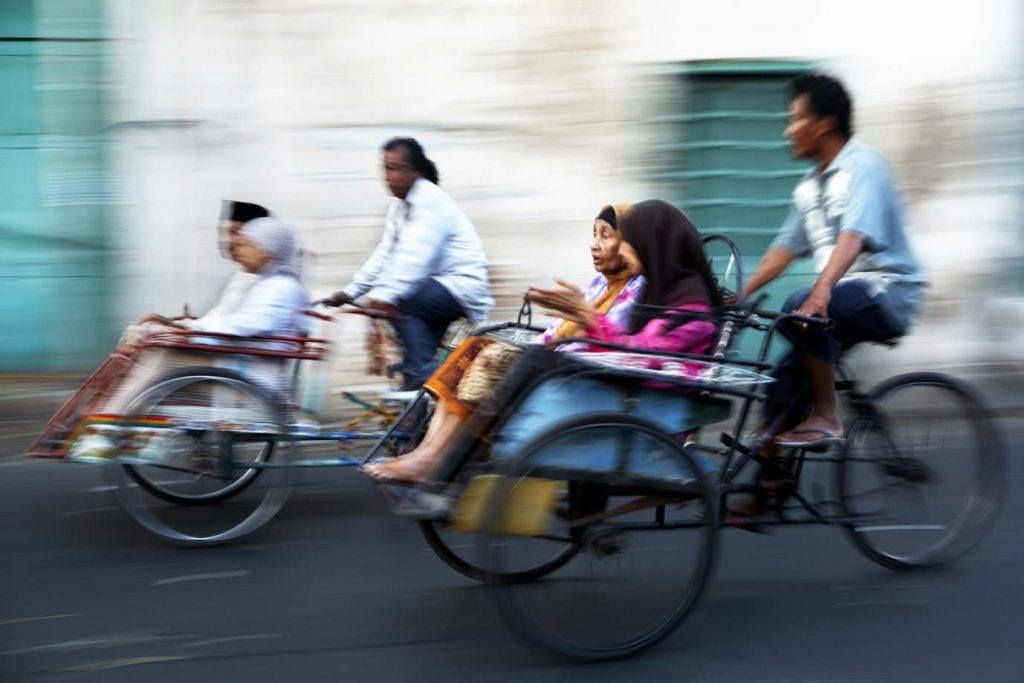
Becak – a cycle taxi that’s very common in the streets of Surabaya, Indonesia. Photograph by Mitchell Kanashkevich
Kent: “Mitchell, tell us about this photograph (above). It appears that you employed a panning technique. Did you go into this situation with a plan? Or were you simply walking down the street and the situation developed in front of you? For those of us that dream of becoming travel photographers, we wonder how much planning goes into it. Do you research an area? Or do you just go and find the shots?”
Mitchell: “I was exploring the old town in Surabaya, Indonesia, and there were all these becaks, or cycle rikshas. They’d be whizzing by every couple of minutes. I thought that it’d be great to show the movement, so I decided to employ the panning technique. I actually hadn’t taken many shots like this back then, so I stuck around for almost an hour. I tried to capture the motion the way I wanted and to wait for characters which seemed interesting to me visually.
I do research certain areas. It really depends. Sometimes I research meticulously. Other times, I just go and see what’s going to happen. Now, as I travel by car, I do the latter much more. I love to see where chance will take me.”
"I think that the actual phototaking is more important than postprocessing, since without a great photo there’s nothing to post-process."
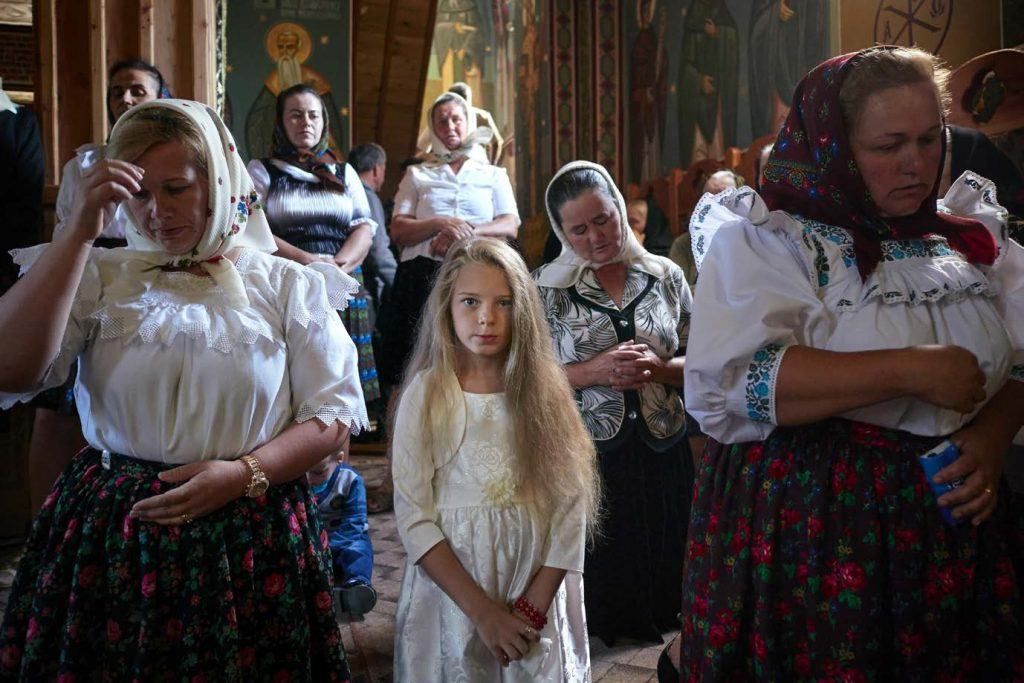
Sunday Mass in a small church in Maramures region, Romania. Photograph by Mitchell Kanashkevich
Kent: “You are a brand ambassador for Panasonic Lumix. How does one become a brand ambassador? Did you go after them, or did they find you? Does that role hold you back creatively, or does it present you with more opportunities?”
Mitchell: “Yes, I am. The story goes like this: I bought a GH4 with the idea of getting back into video. It already had a cult status among independent filmmakers back then. I loved it and shortly after bought a GX7, primarily as a smaller photo camera. Soon, I realized that I was no longer using my Canon gear at all. I shot with nothing but the Lumix cameras for about two years.
By chance, I found out that a friend was a Lumix ambassador in the UK. I asked him for a contact of someone in management who could maybe make me an ambassador too. I didn’t even care that much about getting free gear. I just thought that they were an exciting company, producing exactly the kinds of cameras that I wanted to use. I wanted to be in some way associated with them.
I wrote a proposal with photos, explaining how I’d been using their gear and why I loved it.
They liked what they saw, and I became an ambassador.
The role doesn’t hold me back creatively. I can even shoot with other cameras if I like.
Now I can pretty much get any Lumix gear that I want at no cost, so the idea of using other systems is even less attractive to me. There are definitely opportunities that have come out of this relationship too, like the campaign that I shot for Panasonic last year.”
Kent: “Along the lines of that previous question. I read that you primarily do self-assigned work, and that you rarely take assignments from potential clients. That is mind-boggling to me! How do you accomplish this lifestyle? Where do you market your work that you self-assign?”
Mitchell: “Just to clarify. It’s not that I reject potential clients, it’s just that I don’t go out looking for them. I’ve only rejected one assignment, which was actually really amazing, and I kind of regret it now, but I simply didn’t have the time.
How I accomplish this lifestyle is a complex question, which would be an interview in itself.
But in short, I like to experiment. I’ve always tried different things. But I’ve always put the idea of creating a strong body of work before anything else.
When people wanted to learn how I made my images, I created an e-Book and courses. When my images were found by creative directors or editors, I got some really great gigs.
Having images on Photoshelter has exposed me to some image buyers which I never even thought about, and I’ve made some money that way too.
A key thing, though, is that I don’t have an expensive lifestyle. I don’t even own a house.
Everything that I have is practical and serves a purpose. I’m not into luxury. When you consider all of this, I really don’t need to make much to live comfortably.
This opens me up to creating more work, which in turn brings more opportunities.”
"I like to experiment. I’ve always tried different things. But I’ve always put the idea of creating a strong body of work before anything else."
Kent: “Going back to your Lumix Ambassador role, I watched your video on the Lumix G80 camera, which you shot the stills campaign for. It seems like a really awesome camera. Now that the camera has been around for a while, do you still like shooting with it? Have you moved on to something else that’s a newer model?”
Mitchell: “The G80 really is an awesome camera. It’s a great option if you want a lightweight and very potent hybrid – stills and video camera. I used it quite a bit over the past year, but since I have access to all the gear as soon as it comes out, recently the G80 has actually been replaced by the GH5 in my bag.
I generally like to have a really small, discreet camera for stills, which right now is the GX80 and also a really powerful, yet still portable one for video. That’s where the GH5 comes in.”

Young Israeli female soldiers at the “graduation” ceremony by the Wailing Wall, Jerusalem. Photograph by Mitchell Kanashkevich
Kent: “Tell us how you came to photograph these soldiers. What was the story behind this?”
Mitchell: “I was exploring old Jerusalem, going to some of the usual, well-known places. I had photographed at the Wailing Wall a few times, but on this day there was a ‘graduation from the military service’ ceremony being conducted by the wall.
In Israel both men and women do service in the military. This group, for whatever reason, was women only. I was fascinated, and since no one was kicking me out, I stuck around and shot for as long as I wanted.”
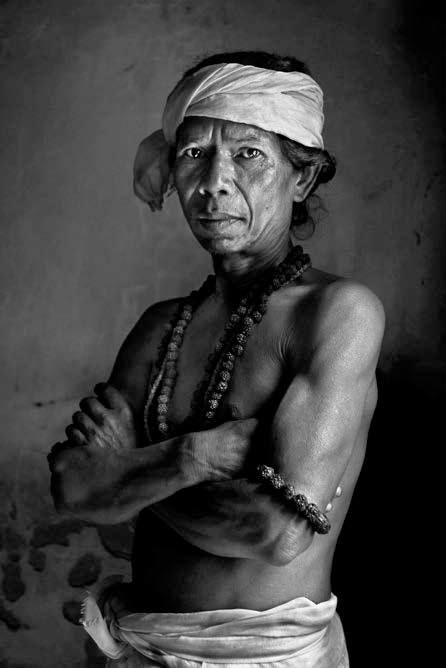
Portrait of a man from the Reang tribe, Tripura, North East India. Photograph by Mitchell Kanashkevich
Kent: “Of your published work (that I’ve seen), the vast majority seems to be color photography. Yet, as this portrait (above) displays, you have created some amazing black and white work as well. Is color photography your preference? Do you go into a situation thinking ‘color’ and only turn to black and white if the conditions don’t warrant good color photography? What’s your philosophy on color versus black and white?”
Mitchell: “In my early years, I did get into black and white photography, but I do not shoot any black and white these days. It’s a personal philosophy, and there are a few reasons. I feel that color – while more challenging – when done right, communicates the mood and feel of the places that I travel to much better than black and white imaging. It’s a much more powerful medium to do what I want to do. It’s a little bit closer to reality as well, since the world is in color.
Also, and I’m sure that many will argue with me about this one, but I feel that black and white is much less challenging. It’s easier to make dramatic black and white photos. Without color, that’s one less component that you have to worry about. I mean, even the greats like Henri Cartier-Bresson admit to having struggled with color photography.”
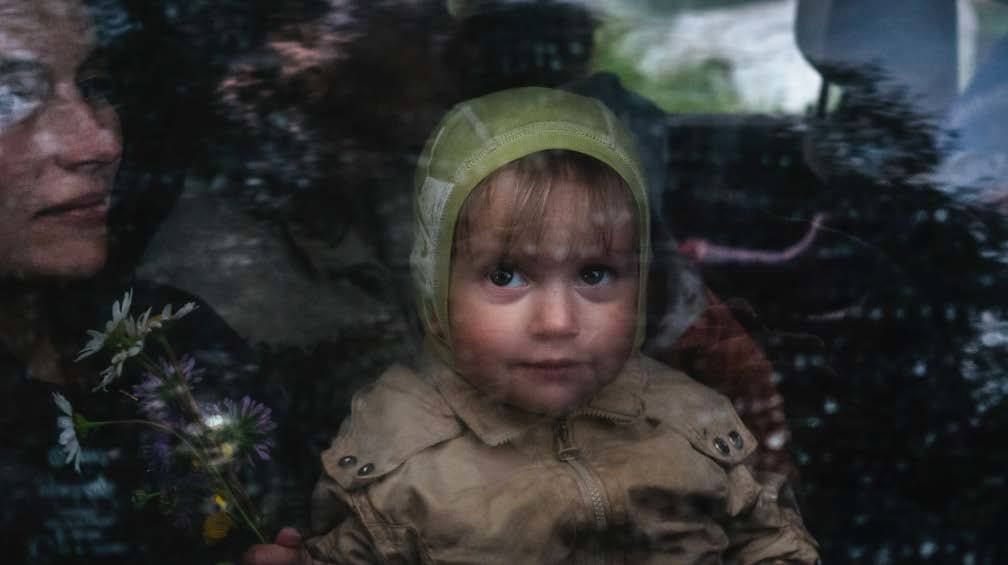
Yana with a flower behind the car window, Braslav, Belarus. Photograph by Mitchell Kanashkevich
Kent: “The photograph of the child (above) was the beginning of a new photographic phase of life for you. Can you tell us what happened and where it took you?”
Mitchell: “When I started shooting with smaller mirrorless cameras, I started to see opportunities that I didn’t see before. The reason was simply that I had the smaller camera with me virtually all of the time. It didn’t feel like a chore to carry it around all day.
This seemingly small thing meant that almost everything became a potential photo subject.
Soon, I was photographing my friends. As my extended family grew, and as we spent time together, it only made sense to photograph them too.
The girl in the photo (above) is one of my nieces. They came to visit me in a countryside house that I was staying in.
Everyone got into the car ready to go, but she kept looking at me through the window. I thought it was a nice situation to photograph. Since I had the camera with me, I did exactly that.”
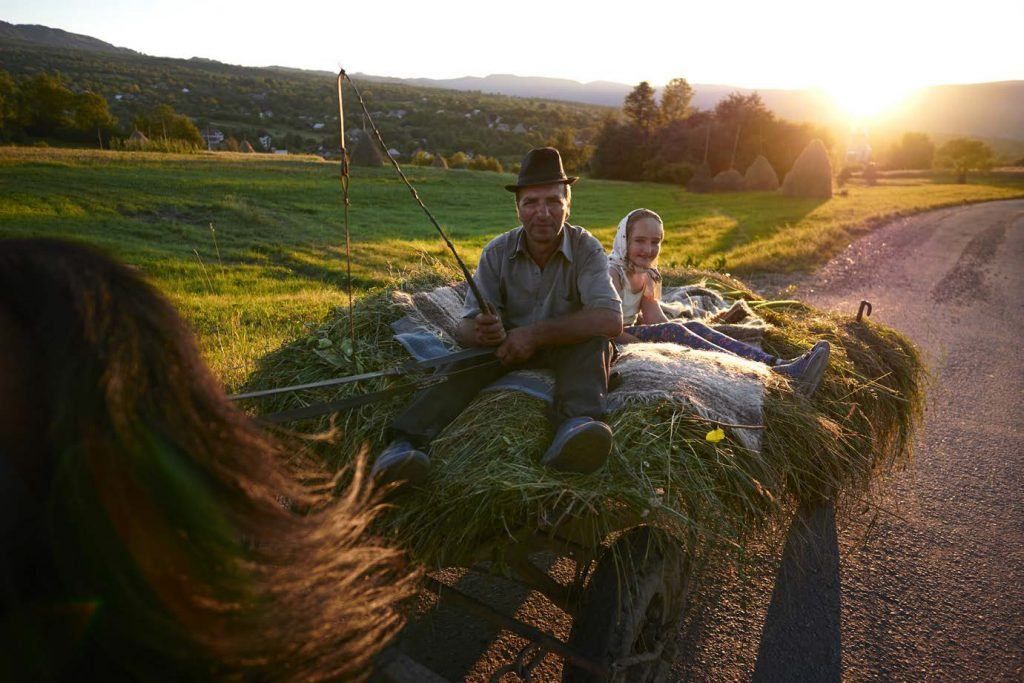
Father and daughter on a horse carriage. Shot for Panasonic Lumix G80 campaign in Romania. Photograph by Mitchell Kanashkevich
Kent: “Outside of your professional photography work, you’ve also taken on the task of training new and intermediate photographers. I find this very interesting because your photographs are typically quite sophisticated, not only in their composition but also in the lighting and use of colors, shadows, and contrast. In your Powerful Imagery training e-Book, do you focus on shooting, post-processing, or both? How do you relate your extreme talent to those that are just learning?”
Mitchell: “Of course, it took me years to get this point of creating the work that I produce now. There actually wasn’t much educational material when I started out. I feel that we have so many short-cuts now – an abundance of educational content. I could have saved so much time if I knew what to look out for, if I could have had an insight into the process of the photographers that I respected. But the educational stuff (outside of workshops) only really started to catch on over the last 8-9 years or so. Before, everyone was hiding whatever secrets they had.
In Powerful Imagery, I go through my creative process. I guess you could say that in this e-Book, I’ve created the blueprint to some of my favorite images by deconstructing them. I delve into various elements during the shoot and the key post-processing steps I took after.
As far as talent, I actually have a theory about this.
In a BBC podcast a few years back I heard that, allegedly, 60% of our intelligence is predetermined. This thought has stuck with me. That’s a really large percentage. It could apply to our creative talents too. So imagine, regardless of what we do and how hard we try, we have that genetic ceiling.
However, there’s another side too. Imagine that you have already been “programmed” with a great deal of creative talent, but you don’t know it or you haven’t discovered it. That talent might be waiting to just pour out of you.
So with my educational content, I feel that for those with loads of talent, things will really click when they read/watch it. I’ll just give them the tips that I wish I had earlier.
Those who are limited talent-wise will still benefit and make the most of what they have. And even if someone has very little talent, they may come to a realization that perhaps they shouldn’t quit their day job to be a pro photographer!”
Recommended Reading: Want to improve your storytelling skills? Grab a copy of this bestselling premium guide, Powerful Imagery, by award-winning photographer, Mitchell Kanashkevich.
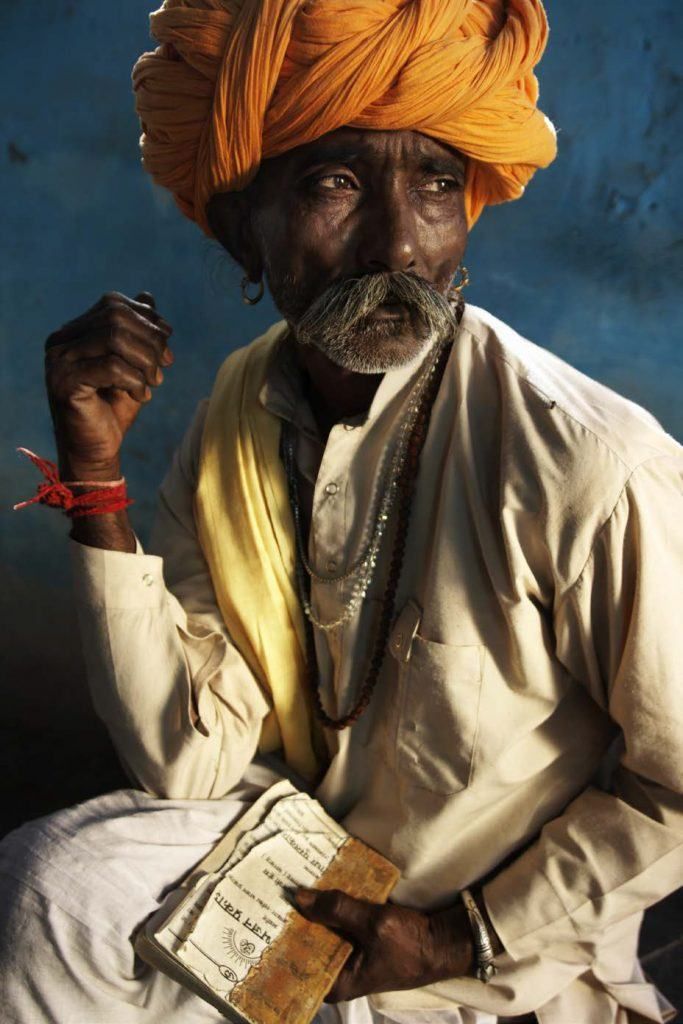
Man with a religious-song book (Bajans) in rural Rajasthan, India. Photograph by Mitchell Kanashkevich
Kent: “I’ve noticed that many of your images present bold color, and bold color contrasts, but they never go over the line. I mean, they always represent realistically. There is a trend in photography to oversaturate colors and push the boundaries of realism with techniques like HDR imaging. What is your take on that? Do you think there is a place for that in your work? Do you use it? What would you like to tell beginning photographers about the use of color in their photography?”
Mitchell: “The more I’ve matured and the more I’ve evolved, the less I’ve been into over-saturating or making things overly contrasty. I’m really not a fan of over-the-top post-processing. It was a fad and everyone was in awe of it when we first saw what we could do in Photoshop and Lightroom. But fads go away. People wake up, and we’re all much more visually educated now than we were even 10 years ago.
There’s definitely room for stylization in photography, but there’s a very thin line between something amazing and something very cheesy and in poor taste. I mean, just because we can make something incredibly saturated or contrasty, or apply a retro film preset, doesn’t mean that we must do it. I’m a fan of doing everything with purpose.”
"The more I’ve matured and the more I’ve evolved, the less I’ve been into over-saturating or making things overly contrasty."
Kent: “You mentioned your daughter. Do you hope she grows up to be a photographer? And along that same line, does your wife take pictures? Do the two of you work together?”
Mitchell: “I really don’t think about what I want my daughter to be yet. I’d prefer her to be a dancer or a singer, personally, and then I can take photos of her dancing or enjoy her singing. But whatever she chooses will be fine by me. I’ll guide her down any path she takes.”
Kent: “I want to share two of your pictures, Mitchell, and then ask you a question.”
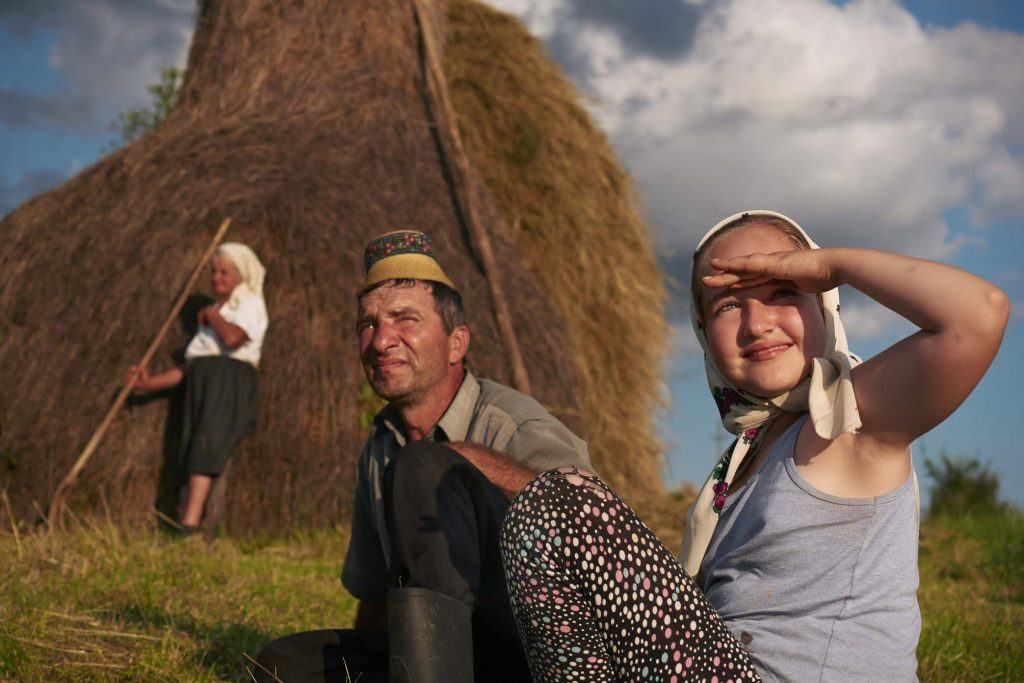
Romanian farmer family taking a break after stacking hay, Maramures, Romania. Photograph by Mitchell Kanashkevich
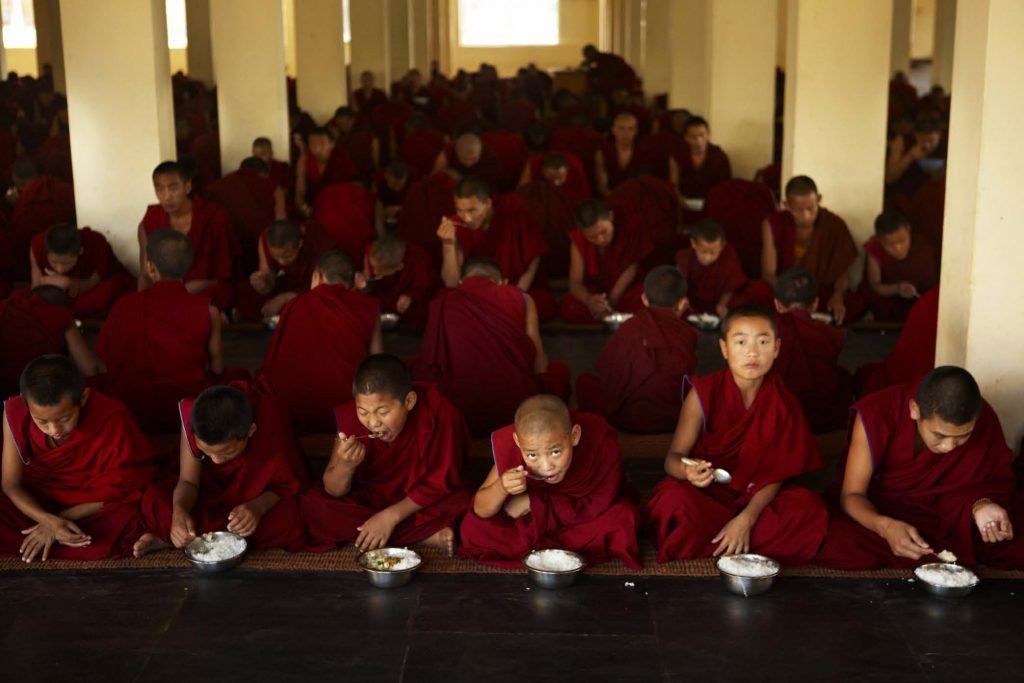
Buddhist monks having breakfast in a monastery in Coorg, Karnataka, India. Photograph by Mitchell Kanashkevich
Kent: “Here we have two different photographs of two very different subjects that were created on opposite ends of the world (images above). One is created outdoors and the other created indoors. Yet, I see many similarities to these two photographs. They are both extremely warm in tone; they both focus in on one individual who is involved in some activity; and they both present supporting characters to the main subjects who display interesting expressions. But don’t overwhelm the subject. Would you call this ‘your style’? How much does post-processing play a part in giving your images ‘the look’ that you want them to have? Do you think about the idea of a style as you’re shooting, or does it just come to you?”
Mitchell: “I’m not sure if I would call this my style. I want to keep evolving and experimenting. I am sure that some things will stay constant, and perhaps that can be called style, but I am not too conscious of that until years later. Later I can look at a whole body of work and say, ‘Ok, there was a similar theme running through these images.’
As far as post-processing, it definitely plays role in certain cases. Subtlety is key. To draw attention I’d brighten the elements that need attention and darken those that don’t. Again, subtlety is key. It is very, very easy to overdo it. You can only get better with practice. Of course, if someone shows you their process, that’s a big shortcut, because you know what to avoid and what to focus on immediately.”
Kent: “You studied motion picture film. Do you ever see yourself returning to that medium – to shooting live action motion?”
Mitchell: “Absolutely. I do think that film/video is a powerful medium. My problem is that I can’t manage to do both at a high level. In fact, I don’t think anyone actually does it well. If I’m after an amazing still image, I’m focusing all my energy on that. If that definitive moment presents itself in front of my camera and I’m in movie mode, I feel like I missed out on that perfect still.
Making worthwhile footage is a little easier in the sense that you don’t necessarily need those split second definitive moments, but if you want to do it well, you still need to immerse yourself fully into the medium. In my mind, you can’t shoot a few stills and then shoot a bit of video and end up with something truly special. Not to say that you can’t end up with quality results, but just not something that’s truly outstanding.
I think at some stage I will devote more time to just motion. I have a dream to go to Cannes for a screening of a film that I made. I hope that I can make it a reality one day.”
Kent: “One last question. This is for me, personally. Many of your photographs are created from a close vantage point to the subject. In fact, they’re really close. Do you ever get nervous? Do you always get permission first? Or has anyone ever lashed out at you? Curious minds want to know
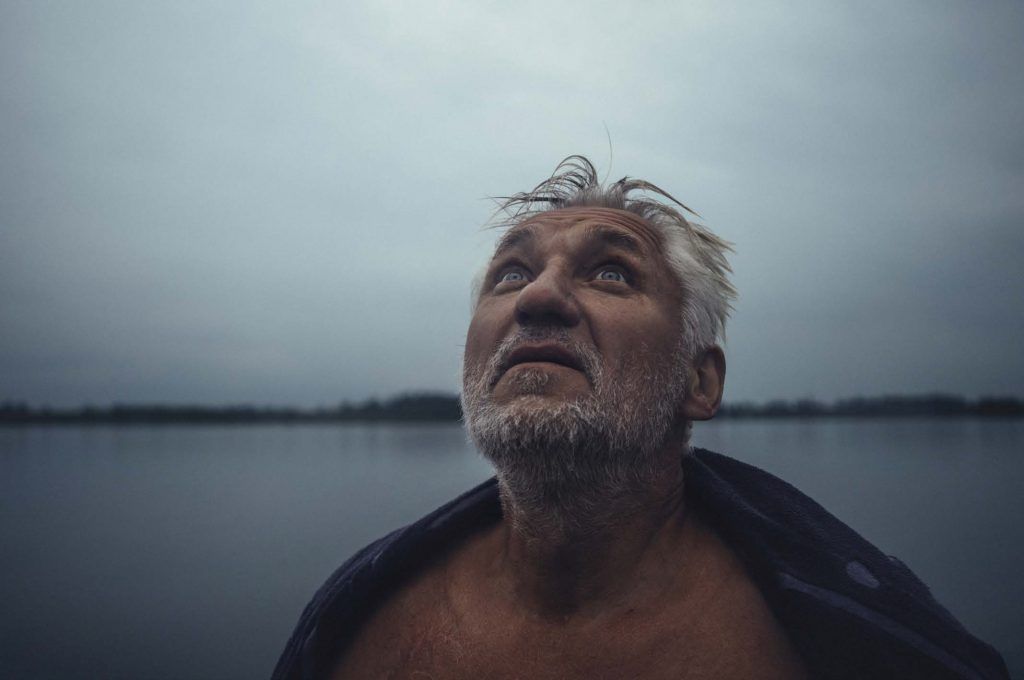
Yuri looking up at the cloudy skies before a rain, Braslav, Belarus. Photograph by Mitchell Kanashkevich
Mitchell: “There’s definitely a sense of nervousness at times. Sometimes I’m overly anxious because I know that I could have the shot. I just need a few things to line up and I’ll have something special. Of course all of this can be ruined if the subject loses interest in being photographed, or if he or she suddenly feels awkward and gives me some uncomfortable look.
Over the years, I’ve had to become a bit of a psychologist, so I can read people pretty well. I generally tread carefully in new places. I’ve never had anyone seriously lash out at me. But I did have a couple of funny experiences in East Africa.
In Somaliland, I was shooting an elderly woman chopping meat with a cleaver. She jokingly shook it at me, telling me to stop shooting. When her friends laughed and told her not to worry, she broke into laughter too, and I kept shooting.
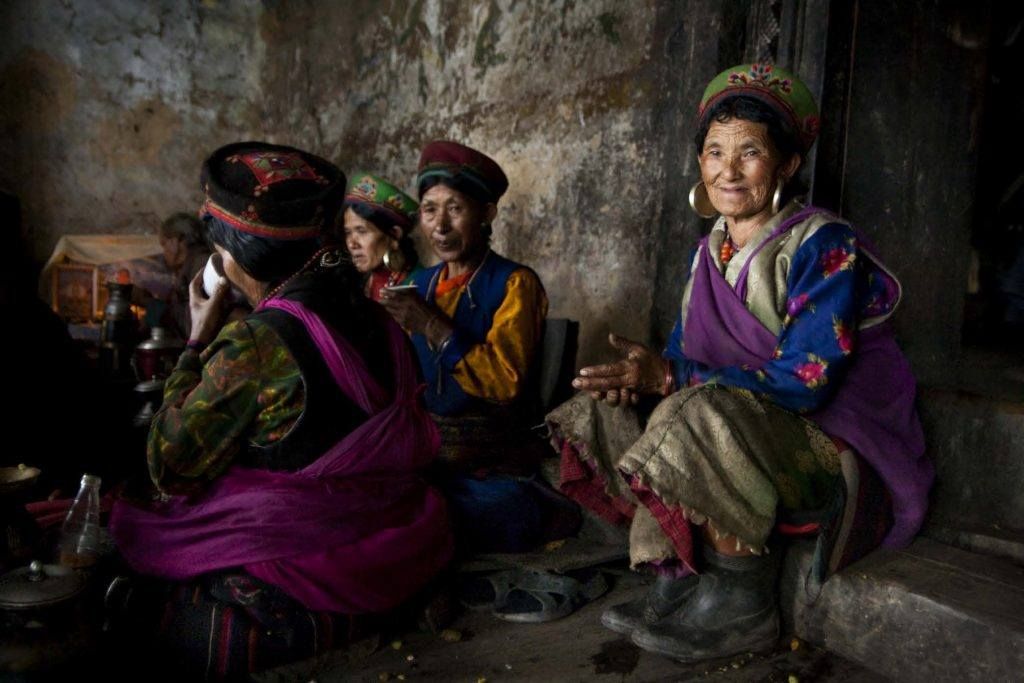
Tamang women at a celebration in a monastery in the Langtang region, Nepal.Photograph by Mitchell Kanashkevich
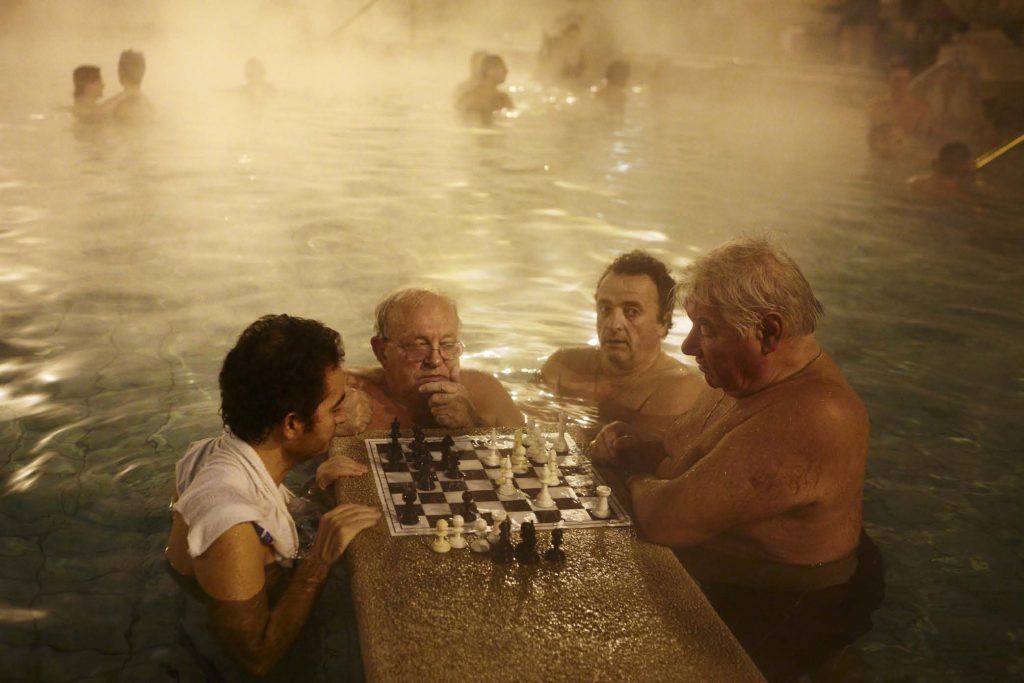
Men playing chess in the Széchenyi thermal baths, Budapest, Hungary. Photograph by Mitchell Kanashkevich
Another time, I was in Djibouti. I was actually shooting a scene at a market, and there was a woman – a mandarin seller – far in the distance. She wasn’t the focus of my image, but for whatever reason she thought that I was photographing her specifically. She got angry and threw a mandarin in my direction.
It was a clear sign that she didn’t want me around, and even though I felt that I was not in the wrong in any way, I prefer to avoid conflict. I guess my philosophy has always been, ‘I can’t think of many situations where it’d be worth staying if I’m not wanted somewhere.’
One of the keys to getting up close and personal is to either have the subject want to collaborate with you in a sense, or to genuinely not mind having you around.”
Kent: “Mitchell, thank you so much for your time. Everyone at Photzy loves your work. We love what you’re doing. Good luck in all of your future endeavors.”
Mitchell: “Thank you, Kent. Some interesting questions. I’ve enjoyed this interview, and I really like what Photzy is doing. I only wish there was something like it when I started.”
THE END
Recommended Reading: Want to improve your storytelling skills? Grab a copy of this bestselling premium guide, Powerful Imagery, by award-winning photographer, Mitchell Kanashkevich.

